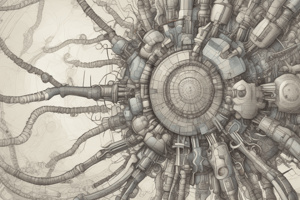Podcast
Questions and Answers
Which of the following expanded nerve endings is most numerous in the lips and tips of the fingers for fine touch?
Which of the following expanded nerve endings is most numerous in the lips and tips of the fingers for fine touch?
- Ruffini's endings
- Krause's end bulb
- Golgi tendon receptor
- Merkel's discs (correct)
What type of receptors respond to mechanical stimuli?
What type of receptors respond to mechanical stimuli?
Mechanoreceptors
Which type of receptor is responsible for sensing temperature?
Which type of receptor is responsible for sensing temperature?
- Krause's end bulb (correct)
- Ruffini's endings
- Golgi tendon receptor
- Merkel's discs
The receptors that detect exogenous chemical stimuli, such as taste and smell, are called ______.
The receptors that detect exogenous chemical stimuli, such as taste and smell, are called ______.
Which receptors are responsible for detecting position and movement sense?
Which receptors are responsible for detecting position and movement sense?
Chemoreceptors only respond to external stimuli.
Chemoreceptors only respond to external stimuli.
What characteristic distinguishes proprioceptors from other types of receptors?
What characteristic distinguishes proprioceptors from other types of receptors?
Which of these receptors is responsible for detecting sustained touch and pressure?
Which of these receptors is responsible for detecting sustained touch and pressure?
Which receptors are chiefly responsible for detecting muscle stretch?
Which receptors are chiefly responsible for detecting muscle stretch?
What type of receptor is uniquely located within the walls of hollow organs like the urinary bladder?
What type of receptor is uniquely located within the walls of hollow organs like the urinary bladder?
According to Muller's Law of Specific Nervous Energy, what happens when a receptor is stimulated?
According to Muller's Law of Specific Nervous Energy, what happens when a receptor is stimulated?
Flashcards are hidden until you start studying
Study Notes
Slowly Adapting Receptors
- Merkel's discs are most numerous in the lips and fingertips, responsible for fine touch.
- Ruffini's endings are responsible for fine touch, pressure, and position senses.
- Krause's end bulbs are responsible for temperature sensation.
Mechanoreceptors
- Respond to mechanical stimuli.
- Examples of mechanoreceptors:
- Stretch receptors: located in skeletal muscle (muscle spindle) and blood vessel walls.
- Tension receptors: found in muscle tendons (Golgi tendon receptor).
- Touch and pressure receptors: present in the skin and subcutaneous tissue.
- Joint receptors: detect position and movement.
- Auditory receptors: located in the Organ of Corti.
- Vestibular receptors: located in the Macula and Crista ampullaries.
Chemoreceptors
- Respond to chemical stimuli.
- External chemoreceptors: detect external chemical stimuli, such as taste and smell receptors.
- Internal chemoreceptors: detect internal chemical stimuli, such as:
- O₂ and CO₂ receptors: located peripherally in carotid and aortic bodies and centrally in the medulla.
- Glucoreceptors and osmoreceptors located in the hypothalamus.
Thermoreceptors
- Responsible for detecting cold and hot temperatures.
Pain Receptors (Nociceptors)
- Respond to noxious stimuli, such as tissue damage
Photoreceptors
- Respond to light waves
- Located in the retina
Superficial or Cutaneous Receptors (Exteroreceptors)
- Located in the skin and subcutaneous tissues
- Free nerve endings: Sense pain, temperature, and crude touch
- Hair follicle receptors: Detect touch
- Meissner's corpuscles: Detect touch and pressure
- Pacinian corpuscles: Detect pressure and vibration
- Merkel's discs: Detect sustained touch and pressure
Deep Receptors (Proprioceptors)
- Located deeper in the body
- Free nerve endings: Detect pain
- Pacinian corpuscles: Located in joint capsules; detect movement
- Ruffini's endings: Similar to Golgi tendon organs, related to joint position
- Golgi tendon organs: Detect muscle tension
- Muscle spindles: Detect muscle stretch
Visceral Receptors
- Located in internal organs (viscera)
- Free nerve endings: Detect pain
- Stretch receptors: Present in the walls of hollow organs like the urinary bladder and rectum
- Chemoreceptors: Present in carotid and aortic bodies; detect chemical changes
Specificity (Muller's Law of Specific Nervous Energy)
- Each receptor is most sensitive to a specific stimulus (adequate stimulus)
- When stimulated, a receptor generates only one type of sensation, regardless of the method of stimulation.
Studying That Suits You
Use AI to generate personalized quizzes and flashcards to suit your learning preferences.




